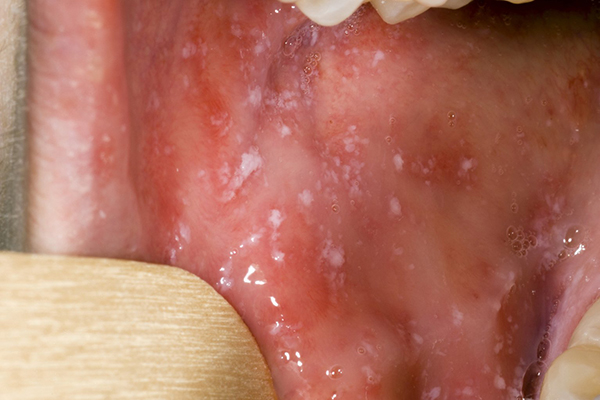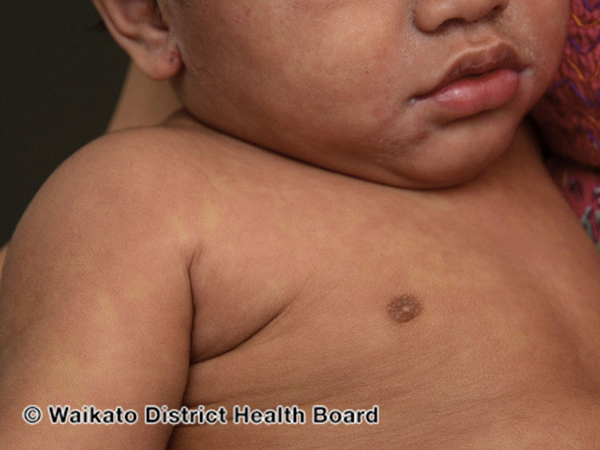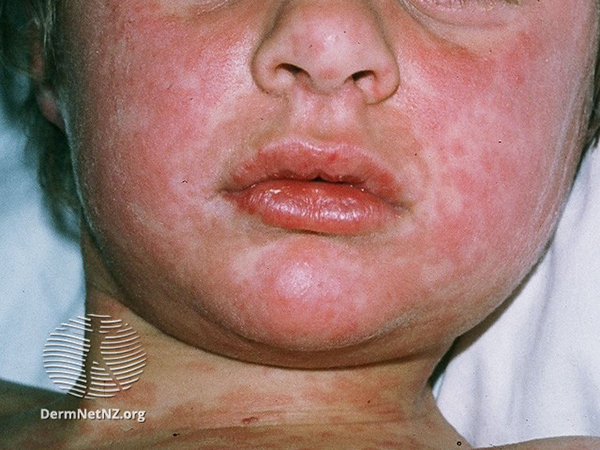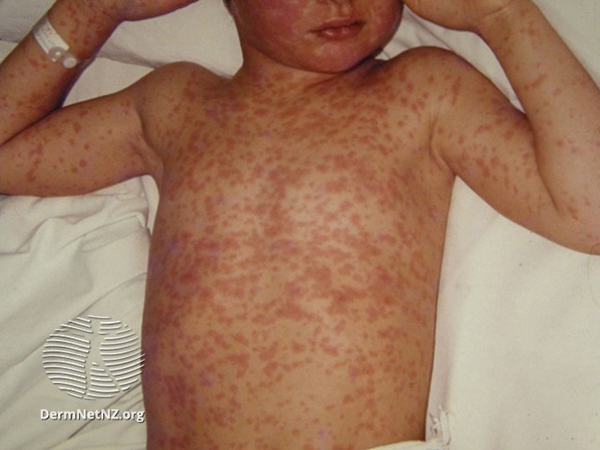

If you think your child might have measles, phone Healthline on 0800 611 116 or your family doctor as soon as possible for advice.
Check the information about measles immunisation [1]
Measles can be a serious disease. It's caused by a virus. Measles spreads very easily from one person to another.
Measles is the most common vaccine-preventable cause of death in children around the world.
It usually takes about 10 days from contact with someone with measles to getting the first symptom but it can take from 7 to 18 days. This is called the incubation period.
The illness begins with the following, which last for 2 to 4 days:
You can sometimes see small white spots (Koplik spots) inside the mouth near the back teeth early in the disease, as in the photo.

A rash follows and the white spots inside the mouth fade.
The rash appears on the head and gradually spreads down the body to the arms and legs. It lasts for up to one week.



If your child catches measles, they're infectious (can spread the virus):

Children usually look and feel quite unwell and miserable with measles. They are most unwell during the first day or two after the appearance of the rash.
1 in 10 people with measles will get complications.
1 to 3 out of 1,000 people with measles will die in developed countries.
1 in 10 people with measles will get complications including:
Measles in pregnancy increases risk for premature labour, miscarriage and stillbirth.
1 in 1000 people with measles develop inflammation of the brain (encephalitis ) - 15 in 100 of these people die and approximately 30 in 100 are left with permanent brain damage.
1 in 100,000 people who have had measles will, years later, develop a serious brain inflammation called subacute sclerosing panencephalitis (SSPE). This serious complication always results in death.
Measles is very easy to catch. It spreads through the air by infectious droplets through coughing, sneezing and talking, or by touching a surface with infected saliva or mucus.
Unimmunised children
All children who have not received at least 1 dose of MMR are at increased risk of catching measles.
About 90 to 95 in 100 people who receive one dose of MMR are protected. Those who do not develop immunity after the first MMR dose, almost always do so after the second dose. 2 doses offers the best protection.
Children with certain immune deficiencies
These children often can't have the MMR vaccine and rely on protection from those around them.
Pregnant women
Measles during pregnancy increases the risk of premature labour, miscarriage, and low birth weight infants.
Immunisation given on time is the only way to prevent measles. 2 doses of the measles, mumps, rubella (MMR) vaccine is 99 percent effective in preventing measles.
Check the information about measles immunisation [1]
Phone Healthline on 0800 611 116 or your family doctor as soon as possible for advice. Make sure to phone your doctor before visiting. That way they can take steps to make sure you don't wait in a public area where other people might catch measles from your child.
If your child has measles, you will need to keep them away from other people (in isolation). That means staying away from:
You should only see people who are immunised aganist measles when you are in isolation.
Your child will need to stay in isolation until they are no longer infectious. The infectious period usually ends 5 days after the appearance of the rash. Your public health service or family doctor should give you advice about this. They should also give advice to people who have been in contact with your child and are at risk of catching measles.
Because measles is caused by a virus, there is no specific treatment.
Antibiotics are not helpful for measles and your doctor won't give them to your child unless your child also develops a bacterial infection as a complication of measles.
In severe cases of measles, particularly when there are more serious complications, hospital treatment may be necessary.
Give paracetamol for pain or discomfort if needed. You must follow the dosage instructions on the bottle. It is dangerous to give more than the recommended dose.
Never give your child or young person aspirin as this may increase the risk of Reye syndrome, which is a rare and serious illness.
Find out about treating fever [2]
Give your child fluids often, to prevent dehydration.
Use saltwater drops (saline) to treat a stuffy nose - ask your pharmacist or family doctor for instructions.
Use damp cotton wool to clean away any crustiness around the eyes. Use one piece of cotton wool per wipe for each eye. Gently clean the eye from the inner to outer lid.
Keep your child at home and resting until they are well and your public health service advises that they can return to school or daycare.
You need to see a doctor urgently if your child:
Dial 111 within New Zealand for urgent medical help (use the appropriate emergency number in other countries) if:
Felicity Lyme, who had measles in 2011, talks about her experience of measles (Ministry of Health video)
Immunisation Advisory Centre. University of Auckland. Measles [3]. [Accessed 28/06/2022]
Immunisation handbook 2020 (measles chapter) [4]. Wellington: Ministry of Health. [Accessed 28/06/2022]
Images
The photo of the small white spots (Koplik spots) inside the mouth is reproduced courtesy of the National Health Service (NHS), UK [5].
The photo of a young child with a measles rash on face, chest and arms is reproduced courtesy of Waikato District Health Board.
The 2 photos of a boy with a measles rash on his face and body are reproduced courtesy of DermNet NZ [6].
Illustration showing symptoms of measles by Dr Greta File. Property of KidsHealth.
This page last reviewed 28 June 2022.
Email us [11] your feedback
Links
[1] https://kidshealth.org.nz/measles-immunisation
[2] https://kidshealth.org.nz/fever
[3] https://www.immune.org.nz/diseases/measles
[4] https://www.health.govt.nz/our-work/immunisation-handbook-2020/12-measles
[5] https://www.nhs.uk/conditions/measles/
[6] https://dermnetnz.org/topics/measles
[7] https://kidshealth.org.nz/node/1514
[8] https://kidshealth.org.nz/node/1518
[9] https://kidshealth.org.nz/node/1512
[10] https://info.health.nz/immunisations/when-to-immunise/immunisation-schedule/
[11] https://kidshealth.org.nz/contact?from=http%3A%2F%2Fkidshealth.org.nz%2Fprint%2F515